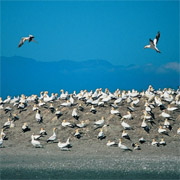Nelson to Golden Bay - Day Three
Farewell Spit

The morning dawns bright and clear for our guided expedition up Farewell Spit and we board a unique 4wd bus, which has tiered seating to guarantee everyone a good view.
En route our guide for the morning, Kersten Franke, provides a brief history of the local region from coal mining in Puponga to the Aorere goldrush of 1857, then tells us that Farewell Spit began life 6,500 years ago and lengthens by six and a half metres every year. “It’s a fragile ecosystem, so no public vehicle access is permitted,” he says, “and only four kilometres of its 35 km length may be seen on foot.”
While the Tasman Sea pounds Farewell Spit’s northern coast, its sheltered southern shores provide a safe haven for shellfish and waders. On this inner beach we spot many natives: white herons, South Island pied oyster catchers, banded dotterels and Caspian terns. As we cross the dunes to the Tasman Sea the migratory birds come out to play. There’s the Turnstone, an inquisitive bird busily examining stranded debris, who will soon be off to the Northern Hemisphere to breed on the Arctic Coast, and throngs of Eastern Bar-tailed Godwits preparing for their journey to North-eastern Siberia. “How on earth do they find the spit when they return here every year,” Bob wonders aloud.
It’s 27 km to the lighthouse along a route that the Original Farewell Spit Safari team knows well as in 1946 they began a mail run to the lighthouse, transporting supplies to the keepers and their families. “Visitors came along for the ride and so the tours began,” Kersten tells us as we disembark to look at crescent-shaped dunes rising high above blackened salt pans, before journeying on to the semiarid surrounds of the lighthouse.
The first lighthouse was built in 1870 from Jarrah, an Australian hardwood, but it was blasted to pieces by the sand so a new steel tower was built in 1897. Inside, over morning tea, we peruse the historical photos plastered all over its walls. “Look here,” says Bob, pointing at a map from 1945 which depicts how fast the spit is growing, “The gannets’ nests didn’t exist back then.”
We climb aboard the bus and continue up the beach, past scattered driftwood and basking seals to the gannets’ nesting site. “Amazing,” says Bob, zooming in with his camera to watch as their smoky-grey young flap their wings in preparation for their inaugural flight.
Later we return by bus to Collingwood to collect the car, then enjoy a late lunch at the Old School Café and Bar in the sleepy seaside village of Pakawau. Earlier in the morning Bob noted the site of another lighthouse, Pillar Point, set high on the rocky outcrops of the Old Man Range. He’s keen to take a look because he says there will be fabulous views of the spit.
We pass through Puponga where the poles from the old jetty begin to protrude as the tide goes out, and shortly afterwards the road ends at Puponga Farm Park, a strip of land created by the government to form a protection belt around Farewell Spit.
An information centre provides details on local hikes including the 20- minute walk to Wharariki Beach with its spectacular jumble of caves, islets, rock pools and sand dunes; Cape Farewell, where Captain Cook said goodbye when he left NZ in 1770; and the Old Man Range and Pillar Point Lighthouse, dubbed ‘blinking billy’ by the locals, which is also the site of New Zealand’s first radar station, used during WW2.
Feeling too lazy to hike we decide instead to ride up with Gail McKnight of Cape Farewell Horse Treks. She assures us that it’s a good easy ride for beginners. “Wharariki Beach is great for advanced riders, they can open up out there,” she says, as I board Bungle, a sprightly cod-liver chestnut with a dark mane and tail. Bob’s riding a beautiful dark horse whom he insists on calling Black Beauty all the way to the top of the range where we’re greeted by absolutely stunning views, a full 360 degree sweep from Farewell Spit through to Abel Tasman National Park. It’s such a clear day that even the silhouette of Mt Taranaki can be seen vaguely on the horizon. “It’s an awesome backyard,” says Gail looking around at us and smiling. “I never grow tired of coming up here.”
Bob snaps merrily away with his camera as the sun begins to drop on the horizon casting a golden glow on the wet sand flats below. Suddenly he jerks up from his camera and waves me over to his side. “Look,” he says incredulously, pointing to Farewell Spit which curves in a glorious golden band below, “It’s just like a kiwi’s beak – that’s how the migratory birds know they’ve arrived home!”